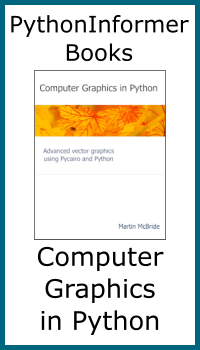Transforming iterables
Categories: functional programming

Higher order functions are functions that act on other functions.
Two important built-in Python higher order functions - map and filter.
map
map applies a function to each element in an iterable, and returns the results as a new iterable.
Here is an example:
import math
k = [1, 25, 81]
e = map(math.sqrt, k)
print(list(e)) #[1.0, 5.0, 9.0]
In this case the map function applies the sqrt function to each of the elements in the list [1, 25, 81]. The result is a sequence containing the values 1.0, 5.0 and 9.0 (the square roots of the numbers in the original list). Note that map creates an iterator - we must convert it to a list before we can print it.
The code above is roughly equivalent to this loop:
import math
k = [1, 25, 81]
e = []
for x in k:
e.append(math.sqrt(x))
print(e) #[1.0, 5.0, 9.0]
The main benefit of using map is that it makes the intent clear. Although the loop in the second example is very simple, you still need to read it to understand what it is doing, because a loop could be doing various different things.
It also makes the code shorter and simpler, so it is less likely to contain bugs.
Finally, map uses lazy evaluation, so that it never needs to store all the elements of the output in memory. If k was a very long list, it could be useful to be able to process it one item at a time so save memory.
filter
filter accepts a predicate and an iterable. A predicate is any function that accepts a single parameter and return a boolean result.
filter applies the predicate to each item in the input iterable, and returns a new iterable that contains only those items for which the predicate returns True.
For example:
def gt_0(x):
return x > 0
k = [1, -2, 3, 2, 0, -1]
f = filter(gt_0, k)
Here our predicate accepts only value that are greater than 0, so f contains the sequence:
1, 3, 2
For more examples see Looping over selected items.
Using lambdas
In the filter example above, we declared a function gt_0 that only gets used is the filter call. We could avoid creating a function by using a lambda function. This allows a simple function to be defined where it is used, without needing to name it (it is an anonymous function). We can define a lambda version of gt_0 like this:
lambda x : x > 0
Or code would now look like:
k = [1, -2, 3, 2, 0, -1]
f = filter(lambda x : x > 0, k)
Related articles
- Introduction to Functional Programming
- Functions
- Pure functions
- Lambda functions
- Iterators
- Iterators vs iterables
- Built-in functions on iterables
- Map/reduce example
- Generators
- Functional design patterns
- Recursion and the lru_cache in Python
- Partial application
- Closures
- Monads
- Failure monad
- List monad
- Maybe monad
Join the GraphicMaths/PythonInformer Newsletter
Sign up using this form to receive an email when new content is added to the graphpicmaths or pythoninformer websites:
Popular tags
2d arrays abstract data type and angle animation arc array arrays bar chart bar style behavioural pattern bezier curve built-in function callable object chain circle classes close closure cmyk colour combinations comparison operator context context manager conversion count creational pattern data science data types decorator design pattern device space dictionary drawing duck typing efficiency ellipse else encryption enumerate fill filter for loop formula function function composition function plot functools game development generativepy tutorial generator geometry gif global variable greyscale higher order function hsl html image image processing imagesurface immutable object in operator index inner function input installing integer iter iterable iterator itertools join l system lambda function latex len lerp line line plot line style linear gradient linspace list list comprehension logical operator lru_cache magic method mandelbrot mandelbrot set map marker style matplotlib monad mutability named parameter numeric python numpy object open operator optimisation optional parameter or pandas path pattern permutations pie chart pil pillow polygon pong positional parameter print product programming paradigms programming techniques pure function python standard library range recipes rectangle recursion regular polygon repeat rgb rotation roundrect scaling scatter plot scipy sector segment sequence setup shape singleton slicing sound spirograph sprite square str stream string stroke structural pattern symmetric encryption template tex text tinkerbell fractal transform translation transparency triangle truthy value tuple turtle unpacking user space vectorisation webserver website while loop zip zip_longest
